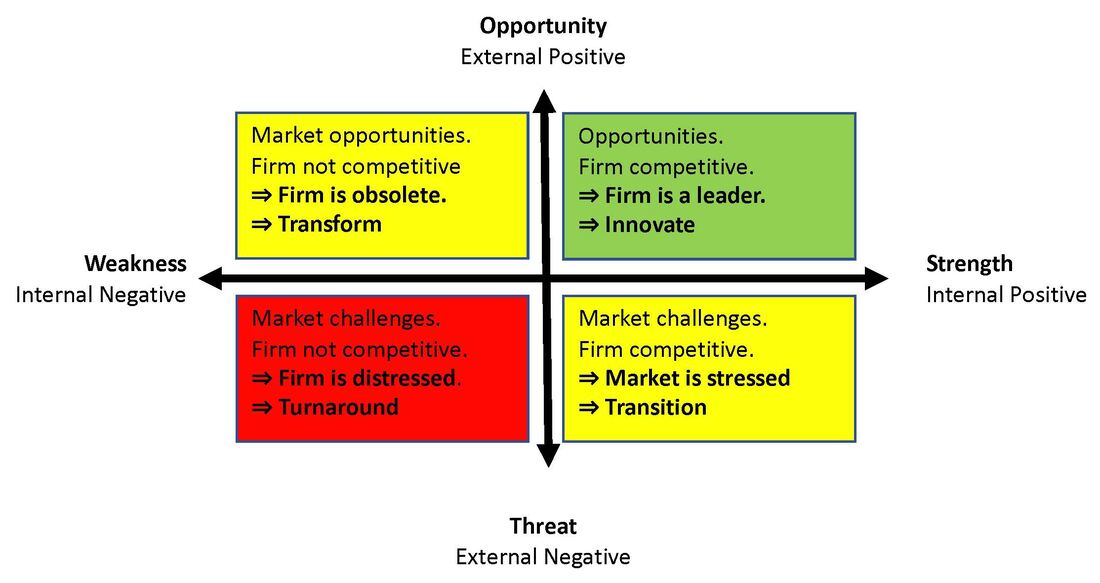Corporate strategy begins with an understanding of the current state of the firm. The state of a company can be defined in multiple ways and Universal Strategy’s3 corporate framework uses leader, obsolete, stressed, and distressed. This framework is based on three questions:
Measuring Corporate State
The problem of looking at the position of a company is not new and there are many models available. One widely used model is the SWOT analysis. SWOT splits the corporate measurement scale into two dimensions:
SWOT Definition
Classifying Corporate Strategy
Expanding on the terms defined so far there is a natural extension to the standard characterisation of the corporate state that is critical for the formulation of strategy:
- What is the corporate health scale that we are using?
- What are the possible corporate states a company can be in?
- Where on the scale is each corporate state positioned?
Measuring Corporate State
The problem of looking at the position of a company is not new and there are many models available. One widely used model is the SWOT analysis. SWOT splits the corporate measurement scale into two dimensions:
- The internal characteristics of the company.
- The external business environment.
SWOT Definition
- Strengths: Positive internal characteristics of the company.
- Weaknesses: Negative internal characteristics of the company.
- Opportunities: Positive external business environment.
- Threats: Negative external business environment.
- Internal characteristics: product adoption rates, cost efficiencies, scale, human capital, efficient processes.
- External business environment: consumer tastes, technological disruption, legislation/regulation, interest rates.
- Successful: Things are going well internally and externally and all indications are that this will continue.
- Obsolete: There is nothing internally wrong with the company, but the external world has changed.
- Stressed: There is an internal issue with the company but the external world is positive.
- Distressed: Both the company and the external environment are stressed.
Classifying Corporate Strategy
Expanding on the terms defined so far there is a natural extension to the standard characterisation of the corporate state that is critical for the formulation of strategy:
- Strengths - Opportunities: How can the company exploit opportunities to its advantage and create barriers of entry to competitors, creating a sustainable leadership position?
- Strengths - Threats: How can a company use its strengths to defend itself against external threats and to further increase its competitive advantage, transitioning into a leadership position?
- Weaknesses - Opportunities: How can a company use the external opportunities to compensate for its internal weakness and redefine itself, transforming into a leadership position?
- Weaknesses - Threat: How can the company minimise its weaknesses to avoid the external threats and use external threats to strengthen its competitive position, turning itself around into a leadership position?
- Innovate: The current state of the company is known, it is in a relatively strong position, the market is positive, and the target state is unknown. The company needs to innovate to maintain its leadership position.
- Transition: The current state of the company is known, it is in a relatively strong position, the market is negative, and the target state is an extension of the current state to a known new corporate state. It needs to transition its product / service offerings to meet the challenges of the market.
- Transform: The current state of the company is known, it is in a relatively weak position, the market is positive, and the target state is not known.
- Turnaround: The current state of the company is weak and unclear, the market is negative, and the target state is unknown.

